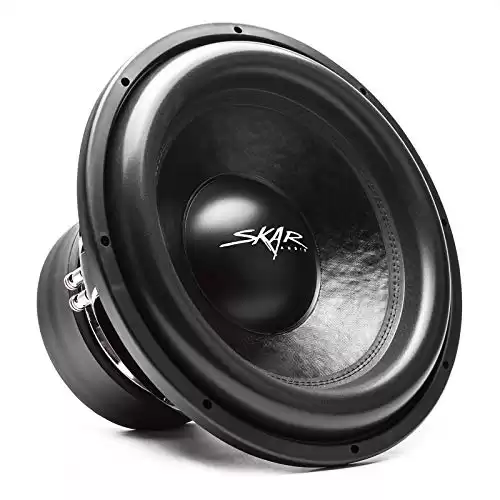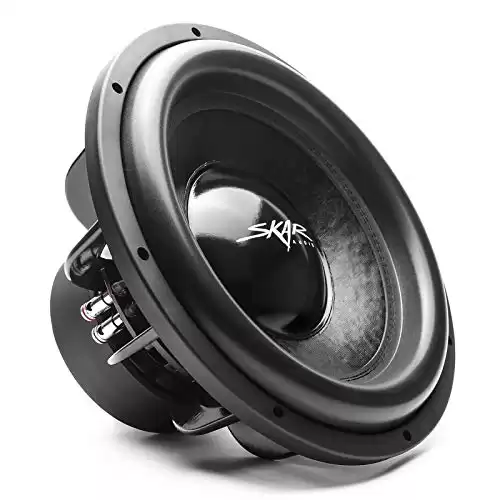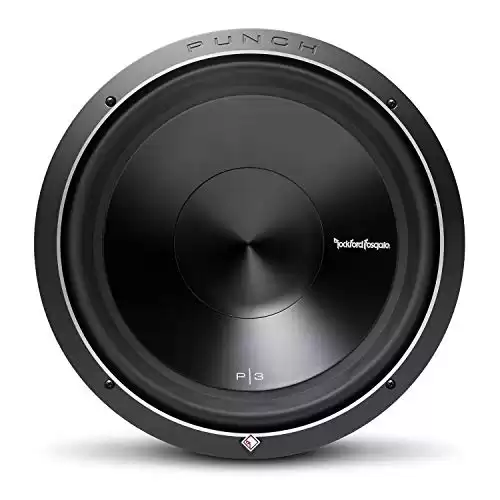If you want to measure the essential factors of a subwoofer’s performance, you’ll look at the sound pressure level (SPL) and low-frequency extension specs for the unit.
When you want music that makes your clothing shake and put an extra beat in your chest, the general rule is that something bigger produces lower Hz frequencies and greater SPL.
Although those two specs are crucial to consider when shopping, several additional factors help measure a subwoofer’s performance.
You’ll find that some big drivers can’t keep up with the accuracy or transient speed you need for a pleasant listening experience.
It’s also important to remember that subwoofer drivers are only as good as the amp and motor backing them. That means a bigger driver doesn’t always translate into better performance.
Pros and Cons of Big Subwoofer Drivers
Size doesn’t always matter when evaluating a subwoofer driver. The best models have an adequate motor to produce force. If you encounter something large that doesn’t have these elements, you can find that some more prominent models sound worse than their smaller counterparts.
It is essential to remember the laws of physics when shopping for subwoofers with big drivers.
If the motor can’t keep up with the rest of the unit, you’ll end up with something akin to a paperweight for your sound system.
When you have a subwoofer with a big driver and a small motor in your car, the setup could sound worse than your stock stereo system!
That’s why a review of the pros and cons of big subwoofer drivers can lead you toward a better product. Here are the advantages and disadvantages you’ll want to consider today.
| Pros of Big Subwoofer Drivers | Cons of Big Subwoofer Drivers |
| Most big subwoofer drivers don’t create phase shifts around the XO point, ensuring that what you hear is tonally accurate. | You can only focus on the designated frequency bands with a single big driver. |
| It delivers a higher sensitivity rate than smaller models or multi-driver setups. | If you have a multi-driver option or multiple units in your setup, you could have each one focus on different frequency bands. |
| You get a bass sound that kicks you in the pants, forcing you to pay attention to the audio. | A single driver will always deliver a narrower frequency range to the subwoofer than other designs, reducing your gear’s usable range. |
| It has an energy that you cannot ignore when playing almost anything. | Bigger drivers typically lack balance and sound definition when playing audio. |
| A bigger driver drives home the lower frequencies to help you feel the bass deep in your guts. | Your IMD can be higher than expected when using this approach to your sound system. |
| You’ll receive more sound amplification and reach with the biggest drivers, allowing listeners to have a pleasant experience at the back of the room. | Bigger drivers add more weight. An 18-inch sub in a cabinet can weigh over 200 pounds. |
How Many Subwoofers Do I Need?
If having one big subwoofer is good, does that mean having two subs or more is better?
When evaluating the pros and cons of big subwoofer drivers, it becomes apparent that determining the best setup for your home, vehicle, or system isn’t always straightforward.
Adding a decent subwoofer to your system supplies additional bass, which is almost always a good thing.
What happens when you start comparing the different sizes of subs that are out there today?
Should you be going after one massive subwoofer with your budget, two decent midsize options, or multiple bargain ones that deliver more of a surround-style experience?
The truth is that you cannot compare different subwoofers when they are different sizes.
If the driver is terrible in a 15-inch model, you’ll have four eight-inch models outperform the bigger one every day.
When the engineers tune the bigger driver for a tighter bass while the smaller ones focus on output, you will experience another performance difference.
As a general rule, you’ll want to use the smaller subs to create a balanced result. If you’re setting up a home theater, it’s better to have four eight-inch subwoofers distributed throughout the room.
When you need some muscle to your sound, it’s often wise to step up to the 12-inch size when the drivers can accommodate the output.
If you want bass frequencies that rattle your teeth and straighten your spine, grab a 15-inch model with the biggest drivers you can find.
Should I Go with Dual Subwoofers?
The truth about twin subs vs. a single subwoofer is that you can only compare the same make and model to reach an answer.
If you’re using the same subs for your system, multiple installations will deliver a smoother response across a wider frequency than a single subwoofer. This outcome is due to the laws of modal averaging.
When you set up the subs for your system, it helps to measure the response to ensure you’re in the ballpark for the frequencies you want.
You’ll find that some subwoofers with big drivers tend to be linear across the entire frequency spectrum, while others have dips and curves that take you all over the place.
It also depends if you have electronic room correction to optimize your response.
If you’re installing a system optimized for listening, a single sub with a big driver would be suitable for the experience.
For the average home, twin subs with smaller drivers might help create balance and smoothness within the lower frequencies.
If you’re an audiophile or want something that drives home a specific point, you’ll want a bigger driver.
Here are the basic “rules” to follow when dealing with subwoofers and size.
- If you use eight-inch subs, a setup with four units is usually the best way to achieve balance.
- When you have 12-inch subwoofers, a twin design offers impressive results.
- A 15-inch sub typically works fine by itself.
- If you get an 18-inch sub, you’ll need to evaluate the frequency response to avoid slamming the rest of your audio.
Best 15-inch Subwoofers to Buy Today
When you select 15-inch subs for your system, you’ll discover that you can get 2-ohm or 4-ohm models from some manufacturers.
If you want something with brightness and speed, the 4-ohm model is your better option.
When your preference is for more balance within the frequency response, take the 2-ohm product.
The price for both for the same sub size should be similar, if not the same, when you work with the same manufacturer.
- Speaker Size: 15 inches
- 2-ohm sq/SPL Car Subwoofer
- Peak Power: 3, 000 Watts
- RMS Power: 1, 500 Watts
- 3" High-Temperature Copper Voice Coil
- Sensitivity (SPL): 89.7 dB
- Powerful 300 oz Ferrite Motor
- Frequency response: 20 Hz - 250 Hz
1. Skar Audio VXF-15 3000-watt Subwoofer
This subwoofer delivers a competition-grade paper cone that the manufacturer stitched with a high roll foam surround.
You’ll receive a frequency response from 20 Hz to 250 Hz with this design, with 1,500 wats of RMS power behind the three-inch high-temperature voice coil.
The SPL rating is 89.7 decibels for the 2-ohm option or 88.7 dB for the 4-ohm subs.
When you select the Skar Audio VXF-15 subwoofer, you’re getting a big 300-ounce ferrite motor that allows for incredible power handling.
You’ll get extended play once it is installed, delivering the super-low FS to hit the lower frequencies while providing impressive high notes.
You’ll want to pair it with an amplifier that does true 6k or more to get a desirable result.
- Speaker Size: 15 Inches (Available in Many Sizes)
- Dual 4 Ohm Car Subwoofer
- Peak Power: 2500 Watts
- RMS Power: 1250 Watts
- 3" High-Temperature Voice Coil
- Sensitivity (SPL): 86.1 dB
- Frequency Response Range: 20 Hz - 250 Hz
- Xmax: 23.5 mm (One-Way)
2. Skar Audio EVL-15 D4 Subwoofer
If you need a lower power option for your car subs, this 2500-watt version from Skar Audio provides an impressive result.
You’ll get 1,250 watts of RMS power, with the competition-grade paper cone delivering the results you want to hear.
The sensitivity is a little lower at 86.1 dB, but it’ll still have an intense and deep bass that feels exceptionally satisfying.
You can go up to an 18-inch model with this design, but I find myself preferring the 15-inch version of the Skar Audio EVL-15 instead.
It delivers brightness without being overwhelming, allowing you to feel the vibrations while enjoying the definition within the audio.
As with the other subs in this series, you’ll get a frequency response range of 20-250 Hz.
- Speaker Size: 15 Inches
- High-Efficiency Class d Amp
- Peak Power: 800 Watts
- RMS Power: 400 Watts
- Shock and Vibration Absorbing Rubber Feet
- Very Low Frequency Response
3. Klipsch SPL-150SW Powered Subwoofer
If you’re looking for a subwoofer that works for your home stereo setup or a theater system, I highly recommend choosing this model.
It features a front-firing internal flare port to ensure you receive placement flexibility.
The manufacturer includes a Class-D amp with the product to give you 800 watts of peak power or 400W of RMS.
The Klipsch SPL-150SW powered subwoofer comes in an ebony cabinet that delivers a scratch-resistant result.
You’ll get shock-absorbing rubber feet, a woven cloth grille, and plenty of additional features that make this investment feel like a luxury experience.
It’s even compatible with the wireless kit from the manufacturer to maximize your placement value.
- Speaker Size: 15 Inches
- 2-Ohm DVC (Dual Voice Coil) Subwoofer
- Peak Power: 1200 Watts
- RMS Power: 600 Watts
- For Sealed Enclosures (Vb): 1.58 cu. ft. (44.7 Liters)
- For Vented Enclosures (Vb): 2.66 cu. ft. (75.3 Liters)
- Mounting Depth: 7.58 in. (192.5 mm)
- Cutout Diameter: 13.94 in. (353 mm)
- Excellent SPL Even at High Volumes
- Anodized Aluminum Cone & Dust Cap
4. Rockford Fosgate P3D2-15 Punch Subwoofer
Although this subwoofer only delivers a 600 RMS rating, it provides a superb listening experience.
Part of the reason for the improved sound is the 10-AWG nickel-plated push terminals and anodized aluminum dust caps and cones.
The audio resonates off of the metals and through a spider-venting design similar to what Skar produces to keep the motor cool on extended playing sessions.
When you grab the Rockford Fosgate P3D2-15 for your system, you’ll have some flexibility with your setup.
If your amps are a little underpowered, you’ll still tap into those lower frequencies with relative ease. You’ll get a loud sound, but it is of high-quality.
It doesn’t snap like the eight-inch versions from the same manufacturer, yet you’ll appreciate how it slams every time you approach the lowest lows.
Are You Ready for a Better Listening Experience?
When you have a big driver for your subwoofer, you can get bass frequencies that rattle your bones.
Although the result can be a lack of definition within the tone received, you’ll get something that demands to be heard.
If you evaluate the pros and cons of big subwoofer drivers, you’ll find that something in the midrange is often more suitable to the average listener.
Should you need performance equipment for a band or your DJ side hustle, subs with big drivers will let everyone be part of the experience.
When you plan a home theater system, you might want to substitute the 15-inch version for something closer to eight inches.
Big drivers can make a difference, but it could be a problematic result. If you want a larger-than-life sound, you’ll want to grab one of the subs listed in this guide to enjoy some extra bass.





